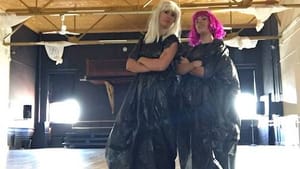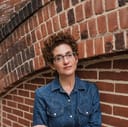Stay in the Loop
BSR publishes on a weekly schedule, with an email newsletter every Wednesday and Thursday morning. There’s no paywall, and subscribing is always free.
Trash and treasure
Mascher Space Cooperative presents 'Loculus//Wotring//Seethaler'

Loculus//Wotring//Seethaler offered an informal evening of dance performed by four artists with connections to the Five-College Consortium in western Massachusetts: Kate Seethaler, Anna Wotring, Olana Flynn, and Madison Palffy. Flynn and Palffy represented Loculus, a Massachusetts-based interdisciplinary performance collective.
The performance began with Seethaler and ended with Loculus, an ordering that traced a trajectory from experimentation and improvisation to polished performance. As I watched, a recent experience at Philadelphia Dance Day was fresh in my mind. This year’s Dance Day, on July 28, featured more than 25 free workshops all over the city for movement and dance enthusiasts of various ages and abilities.
A workshop in experimental improvisation led by Sean Thomas Boyt reminded me that I am no dancer, even though I love dancing almost as much as I love watching dance performances and writing about them. Self-consciousness kept getting in the way of moving and performing with others, and it was a valuable lesson for this writer: when you're sitting in the audience with a notebook and pen, it’s easy to forget how hard it is to make art and to communicate without words.
Art on the spot
My experience at Dance Day helped me appreciate the fearlessness of Seethaler’s improvised solo dance. She began by explaining, “I’m gonna make a dance right now — out of thin air — right before your very eyes.” It was a courageous experiment with different types of movement, everyday actions, music, and speech.
Seethaler first swept the performance floor, describing her work at Mascher caring for the space, and her other jobs taking care of different people and places. Sometimes she moved without speaking and sometimes she moved to music, performing challenging balances and striking poses that transformed from stationary to mobile.

Like many experiments, some parts worked and others did not. Seethaler disappeared behind a curtain for a long pause, and a monologue about hair seemed unrelated until she connected it to earlier themes. Hair and taking care are related, Seethaler pointed out. The routines of chores and childcare mark time, just as “the ever-changing landscape” of hairstyles identifies periods in our lives. The humor and poignancy here capture the potential of Seethaler’s approach.
Shifting balance
Wotring performed next, building on the freewheeling style of the first dance with a piece that incorporated contrast and expressive gesture to evoke both wandering and purpose. Wotring began dancing in silence; music faded in later. She drew her hands to her face in a moving gesture that recurred throughout the piece.
Although Wotring performed alone, the diversity of her movement kept the work engaging. Sometimes she danced quickly, as when she walked in a circle. Other times the pace was slower, allowing for balances on one leg. Another strength of Wotring’s dance was its use of level changes as her body went from upright to an elegant crawl, changing its direction in space as she moved forward, backward, and diagonally.
Wigging out
The performance concluded with Loculus, whose members danced the evening’s most polished and cohesive work. Flynn and Palffy entered to instrumental music that sounded like futuristic clanging, carrying a garbage bag.

They upended the bag onto the stage, and its contents — wigs of different styles and colors — spilled out. Each dancer selected a wig, positioned it on her head, and then straightened the other’s wig before moving.
At times, Flynn and Palffy danced in synchrony, as when they swayed, punching their arms, then raised them overhead like boxing champs. These movements called to mind capoeira and other martial arts, but the dancers lent grace to seemingly combative movements.
For example, Flynn and Palffy combined arm flexes with shoulder shimmies. And when they moved their stiff arms in robotic gestures, their hands remained soft, open, and human. Flynn and Palffy also made excellent use of the space, moving across the entire floor.
Some sections of the piece emphasized sound and music rather than dance, and I found these less interesting. Flynn used the pile of wigs, the garbage bag, a microphone, and an amplifier to create and project a strange soundscape of noise. But I was riveted when Palffy pulled a garbage bag over her head, disappearing inside it to become a kind of moving sculpture, part human, and part plastic.
At the end of the show, Flynn mentioned that Loculus is on tour, mostly performing in music venues and on noise-music programs. It is easy to see why, but Philadelphia audiences were lucky to see them in this evening of dance at Mascher. Making and performing a dance is no small feat, and the work by Seethaler and Wotring suggested the process by which creative experimentation culminates in a unified whole.
What, When, Where
Loculus//Wotring//Seethaler. Choreography by Loculus, Anna Wotring, and Kate Seethaler. August 14, 2018, at the Mascher Space Cooperative, 155 Cecil B. Moore Avenue, Philadelphia. Mascherdance.org.
Sign up for our newsletter
All of the week's new articles, all in one place. Sign up for the free weekly BSR newsletters, and don't miss a conversation.

 Melissa Strong
Melissa Strong